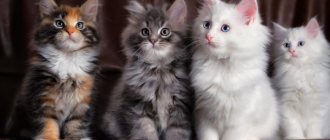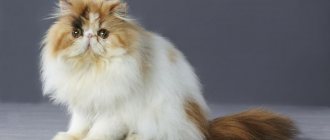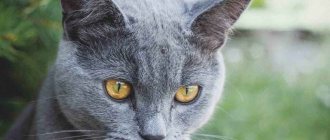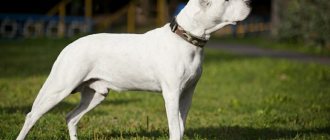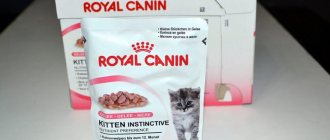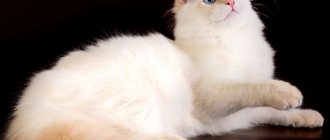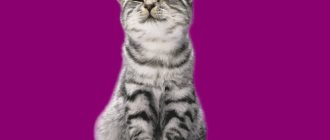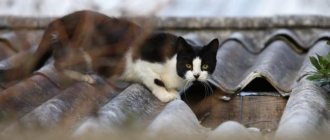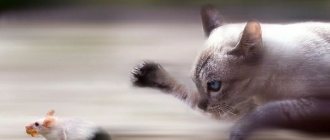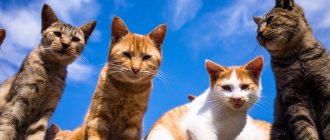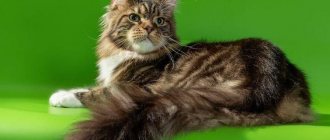History of origin
At the beginning of the last century, one of the American breeders named Nicky Horner wanted to try to breed a completely black cat.
To do this, she crossed the Burmese and American Shorthair breeds. The kittens that were born looked like panther cubs. In 1958, the Bombay cat was officially registered in the list of breeds, gaining the right to take part in exhibitions only after 20 years. Breeders say that it is very difficult to get a perfectly black Bombay kitten. The peculiarity is that when crossing two Bombays, you can get a cub with a “sable” color, which is a disqualifying feature at exhibitions (two genes, when fused, cause recession). And the Burmese and Bombay produce charcoal-colored kittens
In England, Burmese were crossed with ordinary black cats, without paying much attention to the breed. That is why slightly different standards are set for the American and English types
History of the origin of the breed
If the Bombay cat breed were to appear in Bombay, all 33 war elephants would dance a ceremonial dance in its honor. But the Bombay cat has practically nothing to do with India. Her homeland is the USA!
In the 50s of the last century, American breeder Nicky Horner dreamed of breeding a breed of cats similar to pumas that live in the vicinity of Bombay. To do this, it took about 20 years of breeding experiments and the genes of black American Shorthair cats and Burmese cats.
The way the result of these experiments looked did not satisfy felinological organizations and the Bombays were not recognized by society for a long time.
Nicky Horner got tired of fighting the opposition and stopped working with the breed. But the Bombay banner was taken from the weakened Horner’s hands by breeders Herb and Suzanne Zwecker. It was in one of their litters that the cat Luv It Black appeared, which became a cat sensation and was recognized in 1985 as the second best cat by the CFA.
Love It Black changed public opinion and gradually Bombay cats began to occupy an increasingly strong place on the cat Olympus.
However, this breed cannot be called numerous - just 15 years ago, only 97 Bombay cats were registered with the CFA!
What information and documents must a Bombay breeder provide?
Breeders do not have a regulated list of information that they are required to provide to their customers. However, not only conscience, but also competition among Bombay breeders provokes them to qualitatively inform clients about everything that concerns the chosen kitten, thereby providing not only a high-quality “product”, but also a high-quality service. This will undoubtedly benefit buyers.
It is worth noting that persons who sell Bombays without documents, that is, kittens resulting from illegal mating, rarely provide useful information about the pets, since they simply do not know it. According to the new standards, nursery staff must have a “zoological” education, so they can provide complete information about cats and give professional recommendations on care and maintenance. Pedigree kittens must have a certificate, which the owners can then independently exchange for a pedigree (for a fee) and a veterinary passport.
In addition to clubs and nurseries, there are also breeders, but when purchasing a kitten from them, be careful and attentive - many of them do not breed legally. You can buy a Bombay cat from such a private person cheaper, but there is always some risk - whether it is really a purebred kitten, whether it has had all the vaccinations. Be sure to ask for documents about them - otherwise there is a possibility that an unscrupulous nursery or breeder included payment for vaccinations in the price of a Bombay cat, but in fact did not provide vaccinations. This is not only an unpleasant loss of money, but also very dangerous for the health of the animal. Many purebred kittens are predisposed to various diseases at an early age.
Colors
The wool of the Nibelungs is colored blue, in different shades, colors. There is tipping – i.e. the tips of the hairs are painted a certain color. This creates the effect of a shining halo. Tipping can be bright or weak, but the color of the coat should always be rich and deep.
Expert opinion
Dusheba Vera Ivanovna
In 2010, she graduated from the Moscow State Academy of Veterinary Medicine named after K.I. Scriabin with honors, specializing in veterinary medicine. I regularly attend veterinary conferences, congresses, and webinars.
Breeders do not advise allowing your pet to walk under the scorching sun: bright light can ruin the unique color of the coat - it will simply fade.
In the photo there is a cat of the Nibelung breed
Character traits
Unlike many other meowing four-legged animals, the Mekong Bobtail does not walk on its own, but is attached to its owner like a dog - he is ready to accompany him everywhere. If desired, the owner can train the pet to fetch slippers or, upon request, to run after a toy.
In a married pair of Thai Bobtails, the female always dominates - it is she who decides how to properly raise the babies, when to eat and when to sleep. Any mistake by the other half will cause a dissatisfied growl, and in some cases, a serious slap in the face.
Surprisingly, cats never respond with aggression to such menacing attacks in their direction, but meekly agree with the opinion of the blue-eyed beauty.
Males also take an active part in raising offspring; they are the ones responsible for the hygiene of kittens, teaching the intricacies of cat life, and accustoming them to solid food.
Adult cats are not very different in character and temperament from small kittens. But cats with all their appearance show that they belong to the high society of blue bloods - they are independent, proud and stately.
Short-tailed Thais do not know how to scratch: in a fight they would rather use their teeth than release sharp claws. These pets can be safely kept as a guard - if necessary, they will be able to fiercely repel uninvited guests.
A born hunter, the Mekong Bobtail will not give a single small animal a chance to survive, so it is not advisable to have additional fish, birds, and even more so domestic rodents.
Pets love to have heart-to-heart conversations; they have a wide range of meowing timbres; each situation has its own tonality.
Judging by the reviews of the owners, Mekong Bobtails will never offend a child - pets are ready to meekly withstand any childish bullying, no matter how long it lasts. Perhaps the angelic patience is associated with the unusual structure of the animal’s skin: it does not fit tightly to the muscles and grabbing the scruff of the neck does not cause the cat much discomfort or unbearable pain.
Cost of a kitten
To purchase a Nibelung kitten, you can contact Russian Blue breeders. How much does a cat cost? The standard price range in nurseries for representatives of the breed is $700 – $1000. Such a kitten will delight the family as a pet, but cannot be used for breeding work or exhibitions.
Elite kittens should be purchased in the USA, Europe, and Canada. The price for breed-class specimens starts from $10,000.
Animals with short tails
This cat breed is descended from Japanese and Siberian ancestors. They have long hair, a powerful body, love water, swim and hunt well. The Kurilian Bobtail tolerates cold well, so they can be taken out for fishing. They are also good at hunting various rodents.
Animals of this breed have a beautiful appearance and a good mind. They will be devoted and faithful to their owner, and will not leave him in difficult times. The main thing for such cats is human communication and walks in the fresh air. The coat is of medium length, but the advantage is that they shed little.
Japanese Bobtail
Japanese cat breeds look very graceful. They have fluffy and thick fur, and an elongated, pointed muzzle. The tail dimensions are within twelve centimeters. The main characteristic of the animal of this breed is that they resemble a twisted donut, this feature makes them very beautiful. The paws have different sizes, the front ones are shorter than the back ones and due to this, they can overcome any height.
“Japanese bobtails are frequent guests of various exhibitions. They are also easy to train, so, like dogs, they are walked on a leash. The character is very friendly, they quickly get used to the owner and make contact.”
In ancient times in Japan, such cats were worshiped for many years. Also in Japan, it was believed that cats had evil forces in their tails, so local residents kept pets specifically with a small tail or without one at all.
American Bobtail
American cat breeds are very different from Japanese cat breeds. Even at first glance they can be immediately distinguished. The face is round in shape, the fur is slightly long and fluffy, the paws are dense, and the body is muscular.
These cat breeds are very kind and love children. Just like other cats, they need a lot of space and a large territory.
Mekong Bobtail
The history of these breeds began in 2003. They are an exact copy of the Siamese breeds, but with one difference - their short tail.
Russian cat lovers turned their attention to them, and at this time the breed received its official name - Mekong Bobtail
At numerous competitions, these breeds were considered defective and were not allowed into exhibitions because of their strange tail. There are also many legends involving these cats. Siamese cats with short tails actually existed many years ago. They were used as stands for jewelry. There are rumors that princesses took off their jewelry while bathing and put it on the short tail of these animals. And after a while, such breeds became completely unpopular. And in our time they have found a second birth.
They have a dark muzzle, paws and tail. Kittens of this breed are born white, and then over time a dark pigment is formed. They have smooth and silky fur. The eyes are large and blue. Even though Mekong cats are muscular, they are very graceful and slender. Such cats love to play with children, even when they are tormented, they are patient with this and control their actions.
Karelian Bobtails
These cat breeds are small in size. The tail is short, sometimes fractured, from four to thirteen centimeters. The hind legs are much longer than the front legs and this fact is very noticeable. The muzzle is narrow, there are almost no cheeks, the ears are very large and the tassels are slightly visible. These breeds have medium-sized coats.
Karelian breeds are very kind and gentle. They easily take root in any conditions, quickly get used to the owner and obey him. The meowing of cats resembles the chirping of birds, even a little like singing. In normal environments, these cat breeds live in packs, like lions. They get along well with other animals, so they do not have the habit of marking their territory.
Signs of thoroughbred
You can determine the breed of a street cat by its external characteristics. To do this, you need to arm yourself with photos and descriptions of representatives of common cat breeds. Each of them is characterized by a certain body structure, color and type of fur, shape and shade of eyes, height and weight. Knowing these characteristics, by comparison you can with a high degree of probability understand what breed an ordinary-looking pet belongs to.
Features of the body structure (shape of the skull, ears, limbs, tail, etc.)
You can determine a cat's breed by body type:
Kurilian Bobtail
- Stocky with a rounded skull, dense bones, shortened limbs. Bobtail, American and British cats have these features.
- Muscular with a slightly rounded skull and paws of medium length. If your pet has this build, it may be a Maine Coon, American Curl, or Turkish cat.
- Flexible with a rather thin body, a narrow or wedge-shaped skull and long thin limbs. These features are characteristic of Angora and Siamese cats.
Scottish fold
Ears, tail and limbs will also allow you to recognize the breed of the animal. Thus, ears tilted forward are an undoubted sign of a Scottish fold, while ears bent back are a sign of curls. Siamese cats have a long and straight tail, while bobtails have a broken tail. With shortened front legs and a jumping gait, Cymrics have no tail at all. Munchkins and minskins have disproportionately short limbs compared to the body.
You also need to evaluate the width and shape of the skull, forehead, cheeks, degree of expression of the chin, bite, and bridge of the nose. Exotics and Persians can be identified by their flattened nose, graceful Siamese and Javanese by their elongated muzzle.
"Elite" color
Siamese cat
Color in some cases serves as a determining factor in establishing the breed trait. This concept includes the color of the coat and its saturation, as well as possible patterns (tabby, agouti, etc.). Representatives of the Siamese breed are characterized by color point - a combination of a dark muzzle, paw tips, ears and tail with a lighter coat on other parts of the body.
Smoky, blue and silver colors are typical for Nibelungs, British, Scottish and other cat breeds, striped-spotted for Bengals, Savannahs, Safaris, sand for Abyssinians and Somalis, brown for Havana Browns and Chantilly Tiffanys. However, you should not completely rely on this factor when establishing the breed, since many domestic felines are colored similarly.
Eye color and shape
Muzzles of cats of different breeds
When establishing the breed of a pet, you need to look at the shape and color of the animal’s eyes. Thus, in British cats they are light brown, and in Siamese cats there is often congenital strabismus of varying degrees of severity. Turkish Angoras and Vans have heterochromia (multi-colored eyes). Among the owners of white coats of Orientals, Javanese and Persians there are blue-eyed ones. Snow-white Turkish and Scottish cats have yellow eyes with an amber tint.
Expressive almond-shaped eyes with black eyeliner are a distinctive feature of representatives of oriental breeds. Orientals, Abyssinians, Kao-Manis, Thais and Balineses have an elongated eye shape. In addition to their round, wide muzzle and thick coat, nature has endowed the Persians, Scottish Folds, Britons, Exotics and Rexes with large round eyes.
Type of fur or lack thereof
Bombay cat
The type of coat is one of the main characteristic properties of cats of noble blood. The Siamese, Singaporean, Oriental, Tonkinese, Bombay, Burmese, Abyssinian, Russian Blue, American, British, Carthusian and Exotic cats have a short length, while the Balinese, Norwegian Forest, Persian, Siberian, Somali, Turkish, Welsh, Burmese, Maine Coon and ragdoll - long. If the pet is hairless, it is probably a Sphynx, Peterbald, Minskin or Ukrainian Levkoy.
Cornish, Devon and German rexes are distinguished by curly short hair. Laperm, Selkirk and Bohemian rexes have curly and long fur. American cats have a fur coat consisting of short, hard and elastic curls.
Height and weight
These parameters can also be used to distinguish representatives of some cat breeds from others. If the cats are large and heavy, this may be:
- American or Kurilian bobtail;
- Turkish van;
- pixie bob;
- Norwegian Forest, Carthusian, Siberian, British cats;
- Maine Coon;
- savannah;
- ragdoll
Ragdoll
If your pet is too small compared to a normal cat, he may be one of the following small breeds:
- munchkin;
- minuet;
- lambkin;
- Skookum;
- bambino;
- skiff-toy-bob;
- Dwelf;
- minskin;
- Singapore.
Breed Features
Napoleons' original appearance is given by their short legs, flattened, doll-like muzzle, large round eyes and fluffy tail, which looks like a squirrel's.
Representatives of the breed must be strong and round. They are distinguished by agility and jumping ability, which their ancestors, the munchkins, lack. The weight of an adult squirrel cat usually does not exceed 2 kg, and that of a cat – 3 kg.
The color of minuets can be very diverse: monochromatic (red, white, peach or any other), or combining several colors. Based on the type of coat, squirrel cats are divided into the following varieties:
Long-haired. The structure of the coat of such cats resembles the fur of Persians. Short-haired.
In representatives of the breed with this type of coat, it stands upright and feels plush to the touch.
A little about the famous cat Bell
The world's most famous cat with a tail like a squirrel lives in Japan. Her name is Bell and she is almost 4 years old. In addition to its fluffy tail, its red fur color also gives it a resemblance to a squirrel.
Together with Bell, her owner also has a 1.5-year-old red Scottish Straight, Suzu, and a toy poodle, Lindor, who is not yet a year old.
Mistress Bell often delights her subscribers with new funny photos and videos with her pets dressed in a variety of outfits. Obedient Bell endures all her transformations steadfastly.
More than 160 thousand people from all over the world have subscribed to Bell’s owner’s Instagram account, and the beautiful red-haired trio has not left them indifferent.
Photos of the beautiful Bell and other representatives of the Minuet breed once again convince lovers of furry couch potatoes that cats are a real miracle of nature. After all, even one glance at them is enough to lift your spirits.
Care and illness
Long-haired Napoleons need to be combed weekly - 1-2 times
Particular attention should be paid to your pet's tail. If this rule is not followed, the animal’s fur will roll into mats and it will have to be shaved.
Once a month, breeders recommend trimming a cat's claws.
Squirrel-tailed cats are completely defenseless in the wild and require constant care from their owner throughout their lives.
The unique cat with a fluffy tail has quite ordinary health problems typical of Persian cats. The main one is hereditary polycystic kidney disease. This disease is practically incurable and leads to the premature death of the animal.
The structure of a cat's skeleton is subject to serious deformations. Sometimes kittens of this breed are born with congenital deformities and are subject to complete culling. Napoleon breeders also note that periodically the entire litter is born dead. It has not yet been established exactly why this happens.
Source
Breeding the Kurilian Bobtail
Kurilian Bobtails are a young and not yet fully formed breed. Feline specialists and breeders continue to work on its development.
Criteria for choosing a partner
To maintain standard breed characteristics, when choosing a potential mating partner, the following are taken into account:
- length and structure of the tail (preferably the “spiral” type), “retracted bobtail” is excluded from breeding;
- length and structure of wool;
- strict compliance with all appearance standards;
- presence of a pedigree (for newcomers, documented proof of export from the Kuril Islands is required);
- good health and activity.
Finding a partner for the Kuril Bobtail is quite easy, but mating with other breeds is strictly prohibited
How often can a cat give birth?
It is not recommended for cats to give birth more than 1-2 times a year. Otherwise, this may negatively affect the health of the mother and the kittens themselves.
Typically, a Kurilian Bobtail cat has no more than five kittens in a litter.
Description
Since the Bombay cat was bred relatively recently, not everyone knows what it looks like. Often a completely mongrel animal that bears only a vague resemblance to it is passed off as a purebred Bombay. To avoid falling into the hands of scammers, you should purchase kittens only from specialized nurseries, and we will tell you what a Bombay cat looks like, give a description of the breed and some tips on choosing a kitten.
Appearance
Externally, the Bombay cat is very similar to the Burmese. Yes, this is understandable, since both breeds are related. The same elegance of gait, the same grace. However, there are a number of differences - the body is noticeably more elongated, the paws are thinner, the stop is less pronounced.
The Bombay wool resembles the Burmese only in its silkiness. It fits tightly to the animal's body and has a bluish-black color. No inclusions of white or other colors are allowed.
According to the breed standard, the Bombay cat also has the following distinctive features:
- the body is muscular, medium in size;
- wide chest;
- straight tail;
- the head is small, round in shape with a clear stop;
- ears are rounded at the tips, medium in size;
- the eyes are large, round, bright amber in color;
- black nose and paw pads.
You can see more clearly what a Bombay cat looks like in the photo below.
The Bombay cat's calling card is its jet-black, satiny coat.
There is also a British breed standard. It is somewhat different from the generally accepted American one. British Bombay cats are distinguished by their slender body build. They have green and yellow eyes.
Character
Despite the appearance of the formidable Bagheera, the Bombay cat is quite peaceful. She gets along with almost all other pets. She inherited curiosity and playfulness from the Burmese. However, there is no need to be afraid of her activity. From her American Shorthair ancestor she also inherited a balanced character and graceful manners.
The Bombay cat is easy to communicate with. She is sociable and does not tolerate loneliness well. These cats often choose one family member as an object of adoration and sleep only next to him. They resemble dogs in their devotion.
As a rule, they treat children well, but they do not like to be squeezed and dragged around. To a child who respects her, she will become a true friend.
Bombay cats have extraordinary intelligence. It is easy to teach them different tricks, which she will be happy to perform. They usually learn the rules of behavior in the house the first time and strictly follow them throughout their lives.
How to choose a kitten?
A Bombay kitten should only be purchased from specialized nurseries with a good reputation; this is the only way to avoid being scammed. When purchasing, check the metrics and veterinary passport. If you are taking a kitten for breeding, make sure that the mother's pedigree does not include a mark such as a craniofacial defect, which is often found in Bombay cats.
Small kittens may have a mixture of brown or gray hairs and blue eyes. They will acquire their true color only after four months. You can judge what a pet will look like from the appearance of its parents, so ask the breeder to show them to you.
It will not be superfluous to examine the kitten for existing diseases. A healthy baby has shiny, clean fur, without black spots or scratches. The eyes are wide open, brilliant in color, without redness or discharge. He actively reacts to what is happening, when you try to pet him, he does not try to bite or scratch you. The tummy should be soft and the nose should be cold and dry.
Little Bombays bear little resemblance to their parents: they have blue eyes and spotted coats.
Catering
Cats of this breed can be fed both natural food and commercial food. But remember: you will have to choose one thing, since doctors do not recommend giving the Nibelungs one or the other alternately. Balance, the required amount of minerals and vitamins - this is the main requirement for food. What can and should be included in the menu?
Natural products
- Meat: beef, veal, rabbit, chicken, turkey. Lamb meat is also allowed. But pork and duck meat are not allowed: they are difficult for a cat’s delicate stomach, and in addition, they are often infected with parasites. Meat should be given daily, after dousing it with boiling water and cutting it into pieces. Kids are allowed to make minced meat.
- Offal: hearts and ventricles, boiled liver (raw liver causes vomiting), chicken necks, ground into minced meat.
- Fish: only sea fish. These are salmon, hake, trout, sardines and other low-fat varieties. River fish can be toxic to cats. Give no more than once a week, since an excess of fish dishes leads to the development of urolithiasis (and Nibelungs are already prone to this disease). Shrimp and squid are allowed.
- Porridge: rice, oatmeal, buckwheat, pearl barley, millet. The porridge is cooked in water, only semolina is cooked in milk (liquid semolina is used to supplement kittens up to 3 months of age). Can be given 4-5 times a week.
- Vegetables: carrots, pumpkin, zucchini, green beans, cauliflower, greens (parsley, dill, spinach, lettuce), bran. Some cats happily eat vegetables raw, while others need to boil them and mix them with cereal or add them to meat broth. Add to the diet daily.
- Fermented milk products: natural yoghurts, kefir, fermented baked milk, sour cream, cottage cheese, yogurt, cheese. Products should be low-fat, free of dyes and other dangerous additives, preferably unsalted. Can be fed daily.
- Eggs: give whole quail eggs a couple of times a week, boil chicken eggs and feed only the yolk (you can give them 3-4 times a week).
- Oils: vegetable, olive, butter. They are added in small quantities (literally a few drops) to porridge.
- Sprouted oats or wheat. You can't give grass from the street!
Expert opinion
Dusheba Vera Ivanovna
In 2010, she graduated from the Moscow State Academy of Veterinary Medicine named after K.I. Scriabin with honors, specializing in veterinary medicine. I regularly attend veterinary conferences, congresses, and webinars.
Make sure your pet always has access to clean, cool water. It is changed regularly: in the mornings and evenings, and also when it gets dirty. It is recommended to buy bottled water, pass tap water through a filter, or let it sit for 6-8 hours. It is believed that boiled water increases the risk of developing urolithiasis.
Vitamin and mineral supplements are given only after consultation with a veterinarian, as is dry brewer's yeast.
Prohibited list of products:
- Pork, goose meat (both fillet itself and offal);
- Fatty fish, river fish - carps are strictly prohibited;
- Internal fat, lard, tripe, bones, skin;
- Sweets: chocolate, marmalade, marshmallows, marshmallows, etc.;
- Onion and garlic;
- Tomatoes, eggplants, potatoes, peas, chickpeas, mushrooms, sorrel, rhubarb, broccoli;
- Grapes, avocado, raisins, persimmons, citrus fruits;
- Seeds, nuts;
- Pasta, baked goods, salty, smoked, sweet;
- Raw chicken protein;
- Whole cow's milk;
- Coffee, tea, mineral water, alcohol, soda, juices;
- White cabbage;
- Sauces, mayonnaise, seasonings, spices;
- Dog food.
Kittens under 3 months of age are fed up to 6 times a day, from 3 to 4 months - 5 times, from 4 to 6 - 4 times, over 6 - 2 times, like an adult animal.
In the photo there is a kitten of the Nibelung breed
Food should be at a comfortable temperature: neither cold nor hot. Train your cat to eat in the same place, from its own dishes. It is advisable to wash bowls after each meal: Nibelungs are squeamish and will not eat from dirty dishes.
Recommended food
When choosing dry food, it is advisable to choose holistic and super-premium food. Economy class food does not bring any benefit to animals. And premium food in some cases causes allergic reactions. And the percentage of nutrients in both is too small. Feed samples: Innova Evo, Almo Nature, Pronature Original.
Below are recommended super-premium foods. Links with the names of the food are clickable, on them you can, within our website, get acquainted with the descriptions of the food and read reviews from owners of Nibelung cats.
| Premium | Super premium | Super premium |
| Bozita | Superpet | Organix |
Behavioral features
Rodents of the squirrel family belong to active animals that lead an arboreal lifestyle. They make almost no effort when jumping from one tree to another. During the jump, the animal helps itself with its tail and paws. Depending on the type of forest, the appearance of the place of residence changes:
- in deciduous forests the rodent lives in a hollow, the bottom of which is lined with dry grasses or lichen;
- in coniferous forests they make nests for themselves, which they build from branches; they lay wool, moss, and dry leaves on the bottom.
The animal can occupy empty bird homes. The number of such nests in one squirrel can reach 15; it can change its place of residence every two or three days. Thus, from 3 to 6 squirrels can winter in one nest.
Mass migration of animals begins in early autumn. The animals are capable of moving 300 km from their previous place of residence.
Differences from other breeds
There are breeds with which Kurbobs have some similarities. Because of this, a person who has not previously been interested in cat breeds may confuse them. However, they all have their own characteristic features that make them easy to distinguish.
The Maine Coon is a large breed that is somewhat similar in appearance to the Kurbob, but with a long tail. A chicken with a pom-pom tail cannot be confused with it. The main differences between the breeds will be the sizes - the Maine Coon is much larger, and its body is more elongated.
This is interesting! The health of Bobtails is much stronger than that of Maine Coons.
The Karelian Bobtail as a breed was registered in 1994, and in appearance it is very similar to the Kurilets. However, its ancestor is the Norwegian Forest Cat with a gene mutation that causes bobtail. Because of this, the main difference between the breeds is that the Karelians have inherited many of the features from the Norwegians. They are smaller and more graceful than the Kurils, and their muzzle is narrower. The tail does not necessarily have kinks, unlike the Kurbob, and is often just straight and short.
The American Bobtail has been bred by US felinologists since the 60s of the 20th century and is not a natural form. Outwardly, it is similar to the Kurilets, but the length of the tail cannot exceed 7 cm. The American Bobtail also has a convex forehead.
Pixiebob is much larger, and its weight reaches 10-12 kg. Also, Pixie Bobs do not allow a variety of colors and only tabby is recognized as the standard. The main difference between the breeds is their size.
The Cymrik breed is of natural origin, which is slightly smaller in size than the Kuril and has a round eye shape. The tail is very short, and ideally completely absent.
Japanese Bobtail. These cats are smaller and sleeker than Kurbobs, and their paws are taller. The color is usually predominantly white. The Japanese Bobtail is calmer than the Kuril, has good health, does not tolerate cold weather and is more whimsical in food.
A naturally occurring Manx breed. Its representatives should have a tail completely absent. In other parameters they are very similar.
The Mekong Bobtail breed has the coloring of Siamese cats, which Kurbobs do not have. This feature is the main difference between these two breeds of natural origin.
Skif-Tai-Don. The smallest Bobtail breed. The weight of these cats almost never exceeds 2.5 kg. The color of the representatives of the breed is the same as that of Siamese cats.
Cat with a cat
Eye colors
Cat with green eyes
The most common color of cat eyes is green. This color goes well with any color, including gray striped. Very bright, emerald or grassy, rare. Much more often the eyes have an olive or gooseberry tint.
Almost as often, cats have yellow eye shades - light lemon and yellow-green.
Orange iris colors look very impressive and are usually found in ginger cats. Shades range from copper to amber-walnut.
In a white cat with green or yellow eyes, the coat color is controlled by the piebald gene.
The rarest of colors is blue, from light to rich. Typically, white cats have blue eyes, unfortunately, which are associated with various diseases that are associated with the white gene.
An extremely rare case is heterochrony - different colors of the iris. That is, when a cat has one eye, for example, blue, and the other orange. For cat lovers, this combination is considered the most desirable.
Japanese Bobtail
Since ancient times, this cat was considered a friendly animal in Japan, so it was often depicted in various paintings. This breed is popular in China and Korea, as their residents believe that a cat can bring prosperity to the home.
Externally, the Japanese Bobtail is very similar to the Kuril cat, but there are characteristic differences. Firstly, a cat’s nose is not straight, but curved slightly downwards and has a small depression near the forehead. The ears are small and point straight up. The color is white with brown or black spots, sometimes it combines three colors at once.
Japanese Bobtails have a fairly calm and docile character and are very playful cats. They love to be in the center of their owner’s attention and “talk” to him.
Temperament
Bobtails are called cute, affectionate and obedient. These pets make excellent companions. They are not aggressive and get along well with children, older people and cat-friendly playmates.
Although this breed is playful, it is not very energetic. You can expect them to want to play every day, but only a little, otherwise they are ready to lie around and snuggle with their owner all day long. Lie by the laptop on the table while the owner types texts, keep your paw on the mouse and try to help your beloved.
The main characteristic of a bobtail cat is absolute affection. More than anything else, a bobtail wants to love—and receive that love! If you need a good companion pet, then this breed is suitable.
Gentle felines with short pom-pom tails are ideal for families and are sometimes offered as therapy animals to neurotics.
